|
Chapter 10 (part C)
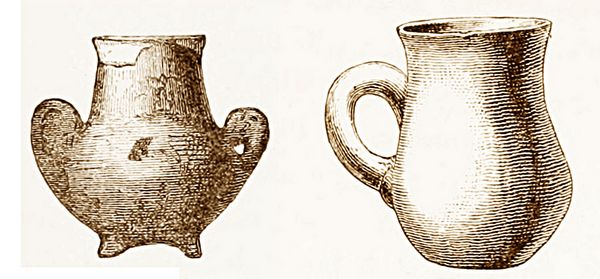 Fig.125 (left):
A curious Terra-cotta Cup
(4m depth).
Fig.126 (right):. Terra-cotta Pitcher of a frequent form (6m depth).
I
now come to the strata of débris at a depth of from 7 to 4 meters (23
to 13 feet), which are evidently also the remains of a people of the
Aryan race, who took possession of the town built upon the ruins of
Troy, and who destroyed it and extirpated the inhabitants; for in these
strata of 10 feet thick I find no trace of metal beyond two nails and a
small piece of silver wire, and the structure of the houses is entirely
different. All the house-walls consist of small stones joined with
clay; in the larger buildings the stones are more or less hewn, but in
the smaller they are altogether rough. Visitors to the Plain of Troy
can see in the earthen walls of my excavations, at these depths, a
number of larger or smaller house-walls of this description. Among
others are the remains of those huge walls 6¼ feet thick, of
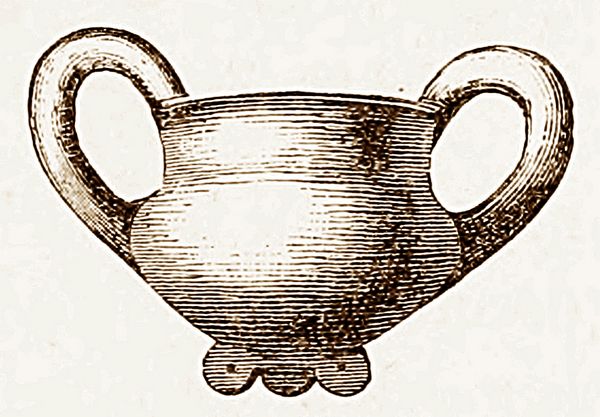 which I
spoke in my report of the 23rd of last month. The foundations lie at a
depth of 20 feet, and they extend to within 10 feet below the present
surface;[167] for as, with the exception of excavating the temple, I
only{167} intend to make the trench through the hill 98 feet broad
above, it has not been necessary to pull down the building entirely.
Fig.127: A small Terra-cotta Vase, with two Handles and three feet (6m depth).
In
these strata (at a depth of from 23 to 13 feet) not only are all the
stone implements much rougher, but all the terra-cottas also are of a
coarser quality. Still it cannot be denied that with all their
simplicity they possess a certain elegance, and I must especially
mention the very pretty black or red vases in the form of hour-glasses
with two large handles, the red ones being nearly 4 inches high, the
black ones 5½ inches high; the small jars in the form of cups with
large handles, the larger jars with one or two handles; but above all
the frequently occurring covers with the owl’s face of the tutelary
goddess of Troy, which are, it is true, almost like those from a depth
of from 30 to 23 feet in size, but considerably inferior in quality.
The
terra-cotta balls found in these strata are especially remarkable,
owing to their most varied symbols. I will describe two of these, found
at a depth of 5 meters (16½ feet). The surface of the one is divided by
lines into eight equal parts;[168] in one of these is a sun with ten
rays, of which only four are straight, all of the others seem to
represent religious symbols. One ray has the form of the Phœnician
letter “Nun,” and must denote lightning;{168} another ray has the form
of a serpent; another again the form of the numeral III.; a fourth is
the shape of a sign-post; and the remaining two in the form of
fishing-hooks; beside the sun is a star. In the next division is a tree
with eight branches, a quadrangle with two stars, and a triangle with
four stars. The third field contains a tree with twelve branches; a
circle with a star; and, beside and above a stroke, twelve stars, one
of which has a dot in the centre. The twelve little stars may possibly
denote the twelve signs of the zodiac, which, being the twelve stations
of the sun, are personified in the Rigvêda by the twelve Adityas, sons
of Aditi, the indivisible and infinite space. The fourth field contains
a tree with only six branches, a triangle with three compartments, in
one of which is a stroke, and also two squares. The fifth field has
again a sun with six crooked rays and one straight ray. The sixth field
has five divisions: in the first there are five, in the second four,
and in the third seven little stars; the fourth division contains a
sign resembling the numeral II., together with three stars; in the
fifth division there is a simple cross. In the seventh field is a tree
with ten branches. In the eighth field there is a figure like a
serpent, and a star.
Upon the second terra-cotta ball there is a
sun with thirteen straight rays; further there are, between two ?,
three groups of three stars each, and four straight lines; lastly,
below the sun three similar lines and three stars.[169] We also
frequently find in these strata terra-cotta balls completely covered
with stars; likewise an immense number of the round terra-cottas in the
form of tops and volcanoes, more than half of which are adorned with
the most various symbolical signs. We have also discovered here many
weapons of diorite and hard green stone, as well as a number of
whetstones of black and{169} green slate with a hole at one end.[170]
The use of these whetstones is not very clear to me, for, as I have
already said, in the depths of from 7 to 4 meters (23 to 13 feet) I
have found no trace of any metal beyond the two nails and the piece of
silver wire. However, we came upon a few fragments of moulds for
casting instruments, and hence it is probable that copper was known. In
any case, however, it was rare and costly, for otherwise I should not
have found such colossal masses of stone instruments.
I found in
these depths a large number of curious large vases, and among them
several beautiful urns with the owl’s head of the Ilian Athena, her two
female breasts, navel, and the two upraised arms beside the head. Upon
one of the navels is a cross and four holes, which are doubtless
intended to represent the four nails employed by our Aryan ancestors to
fasten the two pieces of wood which were laid crosswise for producing
the holy fire.[171] In these strata I also discovered a number of those
cups in the form of champagne-glasses with two handles, which however,
as may be seen from the drawings, become clumsier, smaller, and
inferior in quality at every yard the higher we ascend. Cups with
coronets below (vase-covers) also occur, likewise many small red jars
with three feet and two handles (fig.127), and several hundreds of uncoloured
jars, with a handle from nearly 4 to 4¾ inches high.
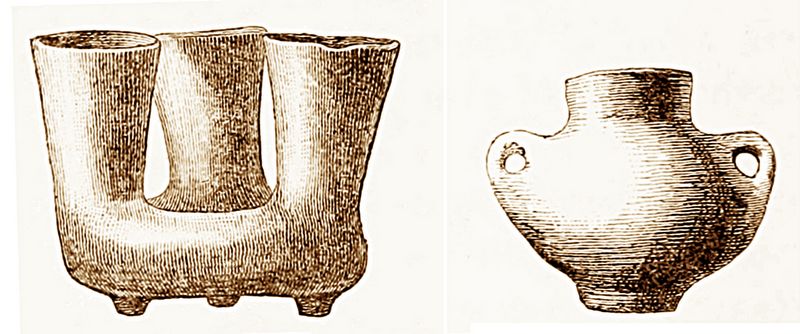 Fig.130 (left): Terra-cotta Vessel (4m depth).
Fig.131 (right): A small Terra-cotta Vase with two Rings for suspension
(3m depth)
There are also enormous masses of large clumsy hammers
and other instruments of diorite; I also found a Priapus of diorite,
which is above 12½ inches high and 7¾ inches thick. There is a well
belonging to this nation, built of good hewn stones cemented with clay;
its opening is at a depth{170} of 13 feet. I have had it cleared out
almost as far as the primary soil; one wall of this well is still to be
seen on the left side of the northern entrance of my great cutting.
Hand mill-stones of lava are also found in immense numbers in these
strata.
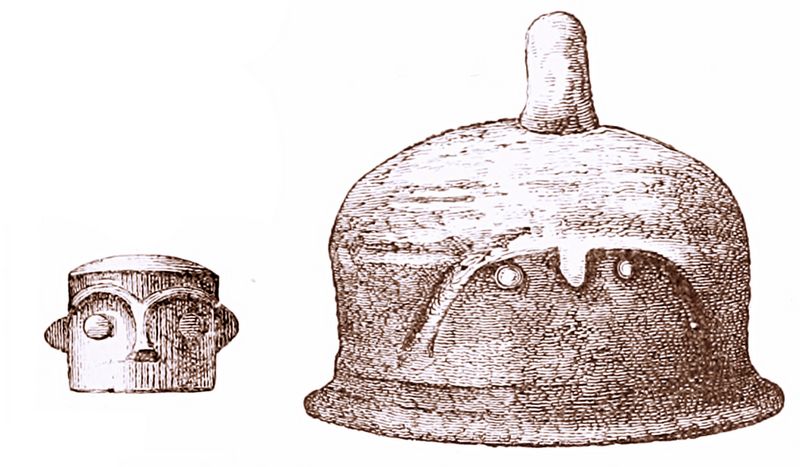
Figs.132, 133: Owl-faced Vase-covers (3m depth). The second (at right) is of an unusual form.
Fig.136: Terra-cotta Vase (2m depth).
Fig.137: Perforated Terra-cotta (2m depth).
A
new epoch in the history of Ilium commenced when the accumulation of
débris on this hill had reached a height of 4 meters (13 feet) below
its present surface; for the town was again destroyed, and the
inhabitants killed or driven out by a wretched tribe, which certainly
must likewise have belonged to the Aryan race, for upon the round
terra-cottas I still very frequently find the tree of life and the
simple and double cross with the four nails. In these depths, however,
the form of the whorls degenerates; they become more elongated and
pointed; I also find many in the form of cones about 1-1/5 inch to 1½
inch in height, which never occur in the lower strata; most of them are
without decorations.
Of pottery much less is found, and all of it is
much more inartistic than that in the preceding strata. However, an
exceedingly fanciful goblet, found at a depth of 13 feet, deserves to
be specially mentioned; its body, which rests upon three little feet,
is a tube, out of which three small cups stand up. We still frequently
meet with cups (vase-covers) bearing the owl’s face of the Ilian
Athena, and a kind of helmet, but they continue to become more and more
rude.[172] In like manner the cups in the form of{171}
champagne-glasses continue to be inferior in quality, they are always
smaller and coarser, and are now only about 5 inches high, whereas at a
depth of 33 feet they were 12-2/3 inches high. Several vases with
female breasts, navel, and upraised arms, occur at a depth of 4 meters
(13 feet), one at a depth of 2½ meters (about 8 feet). Small red vases
in the form of hour-glasses with a handle are still frequently met
with; two were found at as small a depth as 2 meters (6½ feet). A very
great number of{172} small ordinary jars were found at a depth of 4 and
3 meters (13 to 9¾ feet), but they almost entirely cease to be found at
2 meters (6½ feet) below the surface. At the depths of 4, 3, and even
2½ meters (13, 9¾, and 8 feet) I also found very many idols of the
Ilian Athena, made of fine marble; upon several there are engravings of
her owl’s head and girdle.

Figs.138,139: Deep Plates (pateræ) with Rings for suspension, placed (a) vertically or (b) horizontally (1 and 2 M.).
At a depth of 3 meters (10 feet) I also found a
terra-cotta idol, which represents this same goddess with the owl’s
face and two enormous eyes; she has two female breasts and long hair
hanging down behind. Three horizontal lines on the neck seem to denote
armour. At the same depth I also found a small and splendid sacrificial
basin of terra-cotta, with three feet; in the basin there are
engraved{173} a suastika, a tree with twenty-four branches, and a
caterpillar.[173]
Figs.140, 141: Idols of the Ilian
Athena (3 M.).
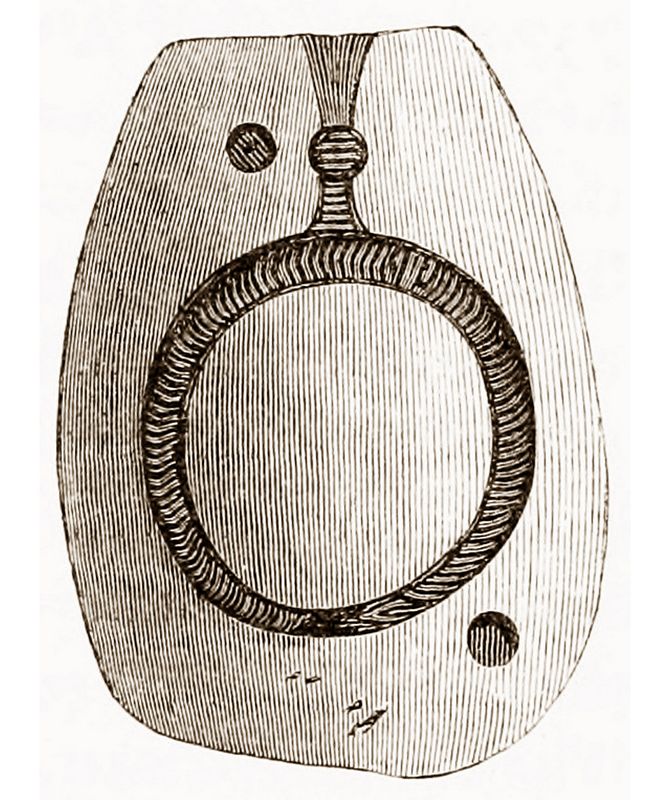 Copper was known to this people, for I
discovered here knives, lances, and nails made of this metal. The form
of the nails is often curious, for occasionally I find them with two
heads, one beside the other, sometimes with no head at all, but merely
two pointed ends, so that a kind of head had to be made by bending over
about 2/5 of an inch at one of the ends. Another proof of their
knowledge of metals is furnished by the moulds in mica-schist (fig.142).
Fig.142: Mould in Mica-schist for casting some unknown object (2½m depth).
We
find scarcely any stones in these strata, and the masses of charred
ruins and wood-ashes leave no doubt that all the buildings of this
tribe were made of wood. I find in these strata of 6½ feet thick some
few stone weights, also a couple of hand-mills of lava, but otherwise
no implements of stone except knives of silex in the form of saws,
which seem often to have been made with great care. Thus, for instance,
at a depth of 6½ feet I found a saw made of silex 4¾ inches in length
and 1·3 in breadth, which was so exquisitely made that I at first
thought it must be a comb. The upper portion of the saw bore the
clearest marks of having been encased in wood.
With
the people to whom these strata belonged—from 4 to 2 meters (13 to 6½
feet) below the surface—the pre-Hellenic ages end, for henceforward we
see many ruined walls of Greek buildings, of beautifully hewn stones
laid together without cement, and in the uppermost layer of all even
the ruins of house-walls, in which the stones are joined{174} with lime
or cement. Moreover, the painted and unpainted terra-cottas,
occasionally found at a depth of 2 meters (6½ feet), leave no doubt
that a Greek colony took possession of Ilium when the surface of this
hill was still that much lower than it is now.
It is impossible to
determine exactly when this new colonization took place, but it must
certainly have been much earlier than the visit of Xerxes reported by
Herodotus (VII. 43), which took place 480 years before Christ.
According to Strabo (XIII. 1. 42) the town was built under Lydian
dominion, and hence this event may have taken place about 700 B.C., for
the commencement of the Lydian dominion is assigned to the year 797
B.C. Fluted jars, which archæologists believe to belong to a period 200
years anterior to Christ, are found immediately below the surface, at a
depth of from 1¾ to 3¼ feet.
The Greek colony does not appear by any
means to have at all extirpated the inhabitants of Ilium, for I still
find a great deal of pre-Hellenic pottery at a depth of 6½ and even of
5 feet. At all events those round lamp-shaped terra-cottas with a
potter’s stamp and two holes at the edge, found as far down as 6½ feet,
seem to me to be of Greek manufacture. The round articles with one hole
through the centre, without or with decorations representing the sun
and its rays, or the sun with stars, or four double or treble rising
suns forming a cross, or even the sun in the centre of a simple or
double cross, occur in numbers as far up as a depth of 3¼ feet; but in
these uppermost strata the quality of the clay of which these articles
are made is very bad, and the symbolical signs are very coarsely and
inartistically engraved.
My wife, who is enthusiastic about the
discovery of Ilium, and who helps me assiduously in the excavations,
found, in a cutting which she and her maid had opened close to our
house, the same round terra-cottas, with or without decorations, even
quite close to the surface. How these exceedingly remarkable objects,
which are adorned with the most ancient religious symbols of the Aryan
race, can have continued to be used{175} for more than 1000 years by
the four tribes which successively held possession of Ilium, and even
by the civilized Greek colony, is to me a problem as inexplicable as
the purpose for which they were used. If, as I now conjecture, they
represent the wheel, which in the Rigvêda is the symbol of the sun’s
chariot, they were probably used as Ex votos, or they were worshipped
as idols of the sun-god, Phœbus Apollo. But why are there such enormous
numbers of them?
The well, which I last year discovered at a
depth of 6½ feet, built of hewn stones with cement, belongs of course
to the Greek colony; so also do all those enormous water and wine urns
(p????), which I met with in the uppermost strata. I find all of these
colossal urns, as well as all those met with in the deeper strata,
standing upright, which is the best proof, if indeed any were needed,
that the mighty masses of débris cannot have been brought here from
another place, but that they were formed gradually in the course of
thousands of years, and that the conquerors and destroyers of Ilium, or
at least the new settlers after its conquest and destruction, never had
the same manners and customs as their predecessors.
Consequently, for
many centuries, houses with walls built of unburnt bricks stood upon
the mighty heaps of stone, from 13 to 20 feet thick, belonging to the
enormous buildings of the primitive Trojans; again, for centuries,
houses built of stones joined with clay were erected upon the ruins of
houses of brick; for another long period, upon the ruins of these stone
houses, wooden houses were erected; and lastly, upon the charred ruins
of the latter were established the buildings of the Greek colony, which
at first consisted of large hewn stones joined with clay or cement. It
can thus no longer seem astonishing that these masses of ruins,
covering the primary soil, have a thickness of from 14 to 16 meters (46
to 52½ feet) at the least.
Footnotes:
[167] Chapter IX., see p. 132-3.
[168]
See Plate LI., No. 493. M. Burnouf’s drawings, from which our engraving
is taken, seem to differ from Dr. Schliemann’s description in a few of
the minuter details.—[Ed.]
[169] On Plate I., No. 491, this ball is represented from M. Burnouf’s drawings, showing six different faces.
[170] See No. 5, p. 24.—[Ed.] Perhaps they were used to polish the terra-cotta vases.
[171] See No. 13, p. 35.
[172] Compare these with Cut No. 74 on p. 115.
[173] See Plate XLVIII., No. 484.
[Continue to Chapter 10, part D]
|
|